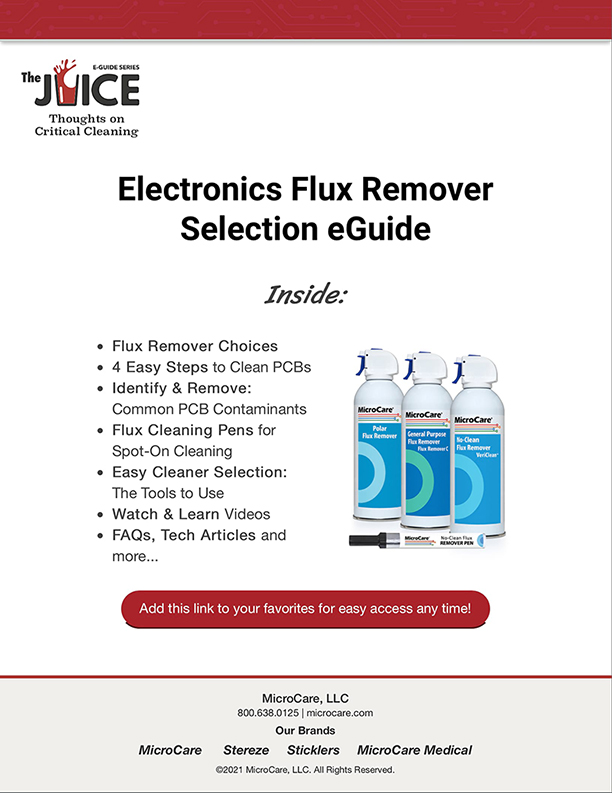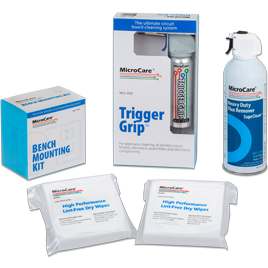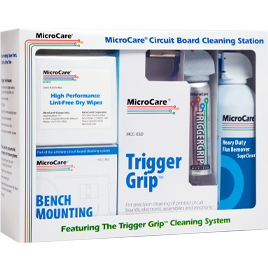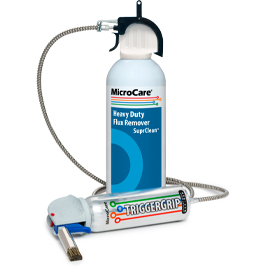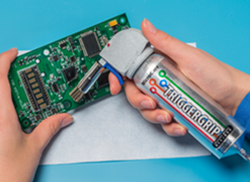TriggerGrip™ PCB Cleaning Kit
Product Information
The TriggerGrip™ PCB Cleaning Kit has all you need to clean PCBs faster, better, safer and more economically
Benefits:
- Fresh pure fluid dispenses with each pull of the trigger to clean and rinse away contaminants
- Cuts cleaning costs by emptying the can completely – no waste
- Patented design reduces cleaning fluid use by 66%
- Targets dirty areas and eliminates overspray
- Cleans in seconds, boosting productivity by 5-9%
- Improves the safety of the work environment by limiting annoying fumes
- Conductive so it enhances your ESD control program
Features:
- Convenient starter kit — everything you need to get started
- Excellent value — Generally saves about 35% over items priced individually
- Durable and reusable, fits most MicroCare aerosols
Kit Includes:
- 1 - TriggerGrip™ PCB Cleaning Tool
- 1 - Bench Mounting Kit
- 1 - Can of Heavy-Duty Flux Remover — SuprClean™
- 2 - Packages of High-Performance Lint-Free Dry Wipes (100 wipes)
Simply connect the TriggerGrip™ PCB Cleaning Tool to a can of MicroCare aerosol cleaning fluid and start cleaning PCBs better, faster and more economically. Ideal for cleaning after rework and repair, especially with hard-to-clean lead-free materials. The TriggerGrip™ PCB Cleaning Tool ensures you perform all four steps necessary for successful cleaning — wet, scrub, rinse and dry. The cleaning power of the fresh, pure solvent is increased with the mechanical scrubbing action of the brush. Also known as the Solvent Miser, the TriggerGrip™ uses less cleaning fluid, slashing cleaning fluid consumption up to 50-66%. The SuprClean™ Heavy Duty Flux Remover cleans circuit boards thoroughly. Lint-free Wipes dry boards well without leaving fuzz behind. Plus, a bench mounting bracket safely keeps the can of cleaning fluid handy and ready-to-use. Special note: the cleaning fluid selection varies outside of North America to conform with local regulations. Custom versions are also available.
Product Details
Product Image |
Part Number | Package | Weight | Size | Technical Data Sheet | Safety Data Sheet |
|---|---|---|---|---|---|---|
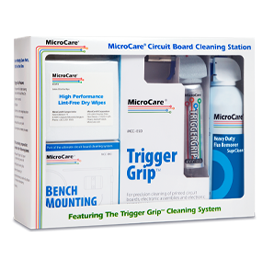
|
CBCSK MCC-CBCSK | Each Kit |
- What's a TriggerGrip™ and How Does It Help Me?
- How Do I Use the TriggerGrip™ System?
- Is Dip-and-Brush Cleaning Good for Cleaning Circuit Boards?
- How Long Does a Can of MicroCare Cleaning Fluid Last?
- How Can I Cost-Justify the Trigger Grip System?
- Are There Toxicity Issues with Trans?
- What's the Best Way to Clean PCBs at the Benchtop?
- How Can I Ensure My People Are Handling Chemicals Properly?
- How Long Will A TriggerGrip™ Last?
- Are There Any IPA Replacement Cleaners?
- What’s the Best Way to Dry a PCB on the Benchtop?
- How Do PCB Cleaning Pens Work?
- How Do I Choose a Contact Cleaner?
- What are the Benefits of Better Quality Stencil Rolls?
- Any NSN Numbers Assigned to MicroCare Cleaning Products?
- Which MicroCare Aerosol Cleaner is the Strongest?
- How Do I Clean Fiber Optic Components on PCB Circuit Cards?
- Why Does MicroCare Have So Many Different Benchtop Cleaning Choices?
- How Long Does a Can of MicroCare Flux Remover Solvent Last?
- Which Cleaner Works Best on Lead-Free Fluxes and Pastes?
- What's Best for Cleaning RMA Fluxes and Pastes?
- What's the Best Cleaner for 'No Clean' Solders and Pastes?
- Why Should I Clean 'No Clean' Fluxes and Pastes? Can I Just Skip the Cleaning and Save Some Money?
- My StatZap™ No Longer Fits on My Micro•Blast™ or Big•Blast™ -- What's Up With That?
- Which Is the Mildest MicroCare Cleaner?
- Which Cleaner is Best at Removing Conformal Coatings?
- What Can I Use to Clean Computer Keyboards, Cabinets and Housings?
- Which Cleaner is Best at Removing Silicones?
- What Cleaner Can I use for Removing Marking Inks, Sharpie Inks and Pen Ink?
- Which Cleaner Is the Best to Remove HumiSeal 1B31 (Acrylic Conformal Coating)?
- How Can I Remove Toner Off Laser Printers and Copiers?
- Which Cleaner Works Best on Light Grease, Oils and Other Lubricants?
- Which Cleaner Works Best on OA Fluxes and Pastes?
- Which Flux Remover Is Best on Ceramic Hybrid Circuits?
- Which Is the Best SMT Stencil Cleaner?
- Which Cleaner Is Best to Use in Automated Stencil Printers?
- What's Best for Cleaning Under Low Clearance SMT Components?
- Which MicroCare Products Meet Mil-spec Cleaning Requirements?
- Which Cleaners Work Best in Ultrasonic Tanks or Dip Tanks?
- Are MicroCare Products Approved for Use in Clean Rooms?
- What Can I Use to Clean the Burned-On Fluxes in My Reflow Ovens and Wave Solder Machines?
- What Cleans Soldering Pallets and Frames?
- What is Causing White Residue on my PCBs?
- Is There a Cleaning Process to Remove Residues and Build-Ups on Wave Solder Machine Pallets?
- How Can I Heat the Reflow Oven Cleaner to Use in a Dip Tank?
- How Do I Dispose Empty Aerosol Cans and Pump Spray Bottles?
- How Can I Clean a Spray Fluxer in a Wave Solder Machine?
- Does MicroCare Have Any Replacements for HCFC-225?
- What's the Best Replacement for nPB Aerosols?
- Can I Get HCFC-141b Alternatives for Cleaning?
- Are MicroCare Products Safe or Hazardous?
- Are Any MicroCare Products Nonflammable?
- Do Flammable Cleaners Create a Hazard on the Rework Bench?
- My People Are Complaining About Solvent Fumes. What Can I Do?
- What Are the NFPA Ratings for the MicroCare Cleaners?
- Do I Need Gloves When Working With MicroCare Cleaners?
- What's the Shelf Life of MicroCare™ Cleaners?
- What Is the VOC Content of the MicroCare Flux Removers?
- What Are VOCs? Which MicroCare Products Contain VOCs?
- Which MicroCare Cleaners Contain VOCs?
- What Does It Mean to Be 'VOC Exempt'? Is the Chemical Still a VOC?
- Is Global Warming a Problem With Any MicroCare Products?
- Do MicroCare Aerosol Products Damage the Ozone Layer?
- Can I Get Refills for My Presaturated Wipes?
- Does MicroCare Sell Freeze Sprays and Dusters ('Canned Air')?
- What Can I Use to Clean Manual Stencil Printers?
- What Flat Wipes (Lint-Free Dry Wipes) Does MicroCare Offer?
- Are MicroCare Wipes ESD-Safe?
- What Is the Liquid Quantity of Cleaner in a MicroCare Package?
- Can I Get Stencil Wiping Rolls from MicroCare?
- What Is MicroWipe™ FP Stencil Wiping Paper?
- Does the Paper Quality on a Stencil Roll Make a Difference?
- What Are the Benefits of Choosing MicroWipe™ FP Paper Over Ordinary Stencil Rolls?
- What's the Technology Behind the SMT Printing Quality Improvements from FP Stencil Rolls?
- How Does the Vacuum Feature Affect My Paper Choice?
- Can I Get Stencil Wiping Rolls in Custom Sizes?
- Does MicroCare Have Competitive Stencil Roll Pricing?
- Do MicroCare Cleaners Meet the F-Gas Rules in Europe?
- Is MicroCare REACH Registered? Which Cleaners Can I Use in Europe?
- Which MicroCare Cleaners Can I Use in Australia?
- Which MicroCare Cleaners Can Be Used in Japan?
- Which Cleaners Can be Used in California?
- How Do I Measure PCB Cleaning Results?
- What's a 'Wetting Index' and Why Is It Important In Cleaning?
- What Does 'Hygroscopic' Mean? Why Is It Important?
- What Is a Kb Value? What Does It Tell Me About My Cleaning Fluid?
- What Is a Toxicity Rating (PEL, TLV, AEL)? Which Solvent Is the Safest (Has the Least Toxicity)?
- What is an Azeotrope? Why Are They Important?
- How Does the TriggerGrip Save Me Money?
- TriggerGrip InfoGraphic
- 4 Types of PCB Contamination and How to Remove Them
- An Early PCB Cleaning Plan Leads to Manufacturing Success
- Cleaning and Drying Before Conformal Coating: Why It’s Important
- MicroCare Offers IPA Alternative Cleaners
- Modern Electronics Require Updated Cleaning Methods
- Modern PCBA Cleaning: Methods to Improve Reliability
- Removing PCB Conformal Coatings
- Use Toxicity Ratings to Help Ensure Worker Safety
- The Meaning of Kb Value in PCB Cleaning
- Why Clean a No Clean Flux
- Flux Remover Selection Guide
- The Importance of Drying in PCB Cleaning
- Ensure Contact Cleaner Compatibility with Today’s Complex Electronics
- All Electronics Cleaning Wipes Are Not Created Equal
- Safer Cleaning Choices Replace nPB in Aerosols for Worker Safety
- Circuit Board Design & Cleaning Evolves to Support Down-Hole Logging Technologies
- Stencil Wiping Fabric Improves Stencil Printer Through-Put

